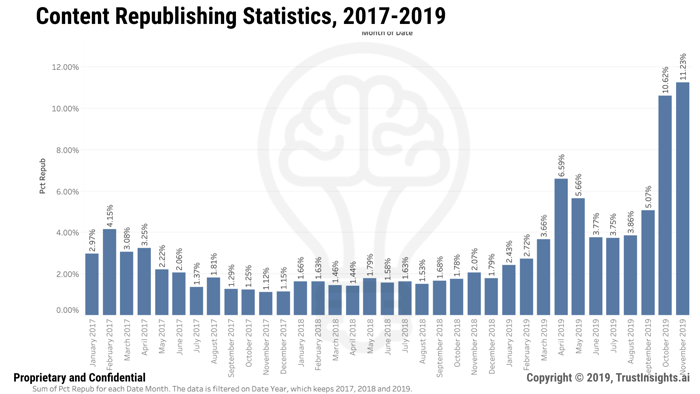Content is a commodity.
Ever heard that? Content is a commodity, produced in bulk, valued as cheaply as possible. Do you think that’s true?
What is a commodity? From the Latin commodus, meaning measured, a commodity is something convenient and useful – but not necessarily special. Financial markets talk about commodities like copper, oil, or rice: raw materials whose value is largely dictated by volume and the lowest price at a minimum level of quality wins the sale. In marketing, we use it to describe something commonplace and easy to obtain.
To an extent, I think we can agree that content has become a commodity, at least in the raw materials sense. Google for any topic and you’ll find results in the millions. Yet when we talk about the ideals of marketing, we talk of differentiation. Unique selling propositions. Brand equity. None of these things apply to commodities as a whole beyond minimum standards of quality, do they?
So how do we escape the commodity trap of our own content marketing?
The opposite of a commodity buyer is a connoisseur, someone with expertise that is fit to judge and critique products, to pass judgement and discern quality. Coffee in bulk is a commodity, but a connoisseur who cares deeply about their coffee may say they only buy an El Salvador Finca Santa Julia Bourbon bean from the Haydee farm in El Salvador. One does not become a coffee connoisseur without extensive study and practice, the same as any profession. To pursue it, like wine tasting or sushi, you have to really care about the field, the study of the field, the minute differences that separate bad from good, good from great, and great from exceptional.
The person who drinks the cheapest or most convenient coffee sees it as a commodity. They don’t care about the specifics or the quality beyond a certain minimum, and that’s okay. The connoisseur carries their own beans, grinder, and press; they will go without rather than have inferior coffee.
So, what does this have to do with content? The difference between commodity and connoisseur is care. Likewise, when we produce content, are we like the mega farm trying to produce the cheapest bean at the lowest cost, or are we looking to produce something sought after by content connoisseurs?
Our role as marketers – if we care enough – is to produce for the connoisseur.
Why go through the effort?
Because while Big Coffee shops can sell you 32 ounces of coffee colored water for a buck, a connoisseur will spend hundreds, if not thousands of dollars per year on the best equipment, the finest beans, and invest even more time into preparing their beloved coffee. They’re a better customer.
Wouldn’t you enjoy having customers who loved you and your content just as much, who made time for you for every piece of content, who made you part of their rituals? How much would that customer spend with you? How loyal would they be as long as you maintained your quality?
The difference between commodity and connoisseur is care. Decide now how much you want that dedicated, loyal customer – and how much corresponding care you will put into your marketing to reach them.

This week’s Bright Idea is our brand new Google Analytics Channel Traffic Forecast. How much will email marketing matter to you next year? What about SEO? Will social media generate real audiences for you? Using advanced predictive analytics, you can know these answers and set realistic goals for your 2020 marketing.
Learn more about Google Analytics Channel Traffic Forecasts here.

In the rear view this week, we take a deep dive into content republishing. One of the standard best practices in content marketing is to take an existing piece of content that performs well and update it over time, so that it continues to attract search queries, audiences, and interest. How widespread is this practice? In an examination of 364 million English-language web pages, we see the following:

What’s clear is that 2019 has been the year of republishing. Compared to the previous two years, every quarter in 2019 has exceeded the median for content republishing; Q4 (QTD) shows an exceptional amount of republishing.
What’s the takeaway here? Twofold. First, be sure you’re republishing and upgrading your best content; double down on what’s working. Second, we have a theory as to why republishing has become so popular: as staffing and productivity have become ever more important, content producers are creating less original content and relying on their greatest hits to continue driving traffic. This offers a counter-intuitive opportunity for those content producers who can create high-quality original content at scale. In competitive topics, there may be opportunities to take market share away from content producers who rely on their greatest hits collection, especially if you can find topics which are adjacent and important to the greatest hits.
Methodology: Trust Insights used the AHREFS SEO tool to extract page metrics for 364,678,000 pages which contain the top 25 words in the English language: “the, of, and, a, to, in, is, you, that, it, he, was, for, on, are, as, with, his, they, I, at, be, this, have, from, or, one, had, by, word, but, not, what, all, were, we, when, your, can, said, there, use, an, each, which, she, do, how, their, if, will, up, there, about, out, many, then, them, these, so, some, her, would, make, like, him, into, time, has, look, two, more, write, go, see, number, no, way, could, people, my, than, first, water, been, call, who, oil, its, now, find, long, down, day, did, get, come, made, may, part”. These words offer coverage of ~90% of web pages in English. The timeframe of the study is January 1, 2017 to November 10, 2019. The date of extraction was November 11, 2019. Only pages still working were included in the study.

- Google Analytics Channel Traffic Forecast
- {PODCAST} In-Ear Insights: Social Networks 2020 Webinar
- Marketing Analytics, Data Science and Leadership via November 11, 2019 Week In Review
- Instant Insights: The AI-Powered SEO Process
- Paradise By The Analytics Dashboard Light #MPB2B
- 5 Practical Applications of AI For Marketing Technology
- AI and SEO in the Post-BERT World: What Marketers Need to Know

Shiny Objects is a roundup of the best content you and others have written and shared in the last week.
Social Media Marketing
- Facebook pretended to care about our security to keep rivals from getting data BGR
- The Ethix
- Case Study: How a Digital Agency Saved Time With Agorapulse
Media and Content
- Quora Marketing: ~1 Million Views Generated. Here’s How to Replicate Our Success
- Marketing 2030: 7 Laws for Content Marketing Success
- What’s Happening in Manufacturing Content Marketing, New Research
Tools, Machine Learning, and AI
- Your martech stack is probably 2X as big as you think it is
- OpenAI Releases Text Generator AI That Was Too Dangerous To Share
- How to avoid the creep-factor when building digital experiences powered by machine learning
Analytics, Stats, and Data Science
- Do You Actually Need a Data Lake?
- Companies Are Bringing Data Back from the Cloud. Now They Need a Place to Put It
- How to Use Paid Search Insights to Optimize Other Marketing Channels
SEO, Google, and Paid Media
- How to Use Google Search Console to Improve SEO (Beginner’s Guide)
- Digiday Research: Marketers are increasingly advertising on retail sites
- Google confirms plans for a search tool that can analyze millions of health records
Business and Leadership
- How CEO Ghost-Posting Affects Employee Perceptions on Leadership, Transparency, and Relationships
- Why do todays marketers lack foresight? And what can they do about it? Econsultancy
- Why Does Business Invest in Education in Emerging Markets? Why Does It Matter?
Join the Club
Are you a member of our free, private Slack group, Analytics for Marketers? Join 500 like-minded marketers who care about data and measuring their success. Membership is free – join today.
Upcoming Events
Where can you find us in person?
- Agorapulse Social Summit, November 2020, Online
- MarketingProfs Virtual Summit, December 2020, Online
- Social Media Marketing World, March 2020, San Diego, CA
- Women in Analytics, June 2020, Columbus, OH
Going to a conference we should know about? Reach out!
FTC Disclosure: Events with links have purchased sponsorships in this newsletter and as a result, Trust Insights receives financial compensation for promoting them.
In Your Ears
Would you rather listen to our content? Follow the Trust Insights show, In-Ear Insights in the podcast listening software of your choice:
- In-Ear Insights on iTunes/Apple
- In-Ear Insights on Google Podcasts
- In-Ear Insights on all other podcasting software
Social follow buttons
Make sure you don’t miss a thing! Follow Trust Insights on the social channels of your choice:
Conclusion
Thanks for subscribing and supporting us. Let us know if you want to see something different or have any feedback for us!













